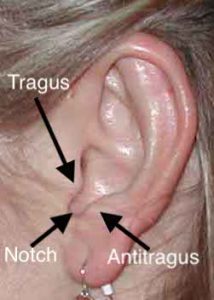Despite its small size, the ear is composed of numerous discrete anatomic landmarks. Occupying less than 15 cm2 on the side of the head there are fifteen (15) distinct structures that comprise it. The complex topographic shape of the ear is best thought of as various convexities and concavities that often parallel each another.

Much of the incisions of facelift surgery are made in and around the ear in a near circumferential manner. Because of these incisions and the tension that may be inadvertently placed on them, visible scarring and ear landmark distortions may occur. The most common ear structure distorted from facelift surgery is the earlobe…which is the structurally weakest part of the ear because it contains no cartilage.
But an adjacent structure may also get distorted in the process when the earlobe becomes elongated. The intertragal notch may become widened as well as the earlobe tilts downward. While there are no specific numbers that describe an aesthetic intertragal notch width or length, when it becomes widened/elongated the ear takes on a peculiar appearance.

Deformity of the intertragal notch can occur from facelift surgery when the earlobe is pulled down. Rather than using local skin flap elevation like is done for Pixie earlobes, cartilage manipulation can be primarily used to reduce the intertragal notch deformity.
Dr. Barry Eppley
Indianapolis, Indiana



